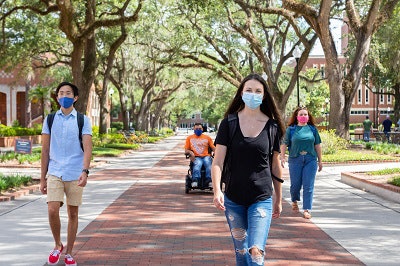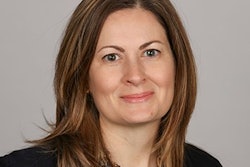As the Pfizer vaccine for COVID-19 begins to roll out to states, many in the higher ed sector and beyond are beginning to look forward to some sense of normalcy.
The University of Florida (UF), for example, is planning to offer roughly the same number of in-person class sections as the institution offered in the spring of 2020, before the pandemic hit.

“It’s not a small number of students who have expressed an interest in getting the in-person experience,” says Steve Orlando, UF’s assistant vice president for communications. “… Because they have interest, we think it’s important to provide that experience for them.”
Orlando says roughly 40% of UF undergrads who have registered for classes for the spring are taking at least one in-person class. In-person class capacity is being reduced by 80%; the remainder of students will receive synchronous instruction online. Classes will be physically distanced, with students six feet apart and professors up to 11 feet from the students, and masks are mandatory inside all university buildings. All faculty members will be provided with five N-95 masks and some disposable masks to hand out to students who may have forgotten theirs. There will be hand sanitizer located in every classroom, which will be cleaned daily.
“Our president, Kent Fuchs, has said, as the pandemic has progressed, that his approach is that we need to learn to live and study and work through the pandemic,” Orlando says. “We are trying to figure out the best ways to do that while keeping our students, staff and faculty safe. We feel like with the safeguards we have in place, what we’ve learned, we can do this” in partnership with UF Health and strong adherence to Centers for Disease Control guidance.
Orlando says about 200 of the university’s roughly 5,000 faculty members have expressed concern and requested accommodations, with most requesting to be able to continue teaching remotely. Though not all will be able to remain fully remote, Orlando says the university did grant some form of accommodation to all faculty members who have requested it, and some have received additional personal protective equipment.
A multi-pronged approach
At Delaware State University (DSU), an historically Black campus located in the state’s capital, officials are planning to remain mostly virtual, but they are slowly increasing the number of in-person sections on campus from 17% in the fall of 2020 to 25% in the spring of 2021. University officials are expecting to welcome 1,990 students back to campus housing, up from 1,784 who arrived in late August, but most of those students will continue with a hybrid learning model.
Through a number of public-private partnerships, university officials were able to implement twice weekly testing in the fall semester to help identify and isolate asymptomatic COVID-19 carriers and minimize the spread of the disease on campus. All but one of the individuals identified as having the disease were asymptomatic.

“We learned that no single strategy works,” says Steven Newton, director of media relations at DSU. “It required a combination of mandatory universal mask wearing, social distancing, twice-weekly testing and rapid contact tracing to have a workable plan. Then you have to ‘sell’ that plan to the community. We got buy-in early from two really important student constituencies — our Student Government Association and our student-athletes — and they did a huge job in helping drive the message about staying safe.
“We are convinced that the rapidity of contact tracing and quarantine prevented some of our individual COVID positives from becoming the basis of community spread,” as it has been in other university communities, like Ann Arbor, Michigan, which is home to the state’s flagship university.
The institution secured a $1.5 million grant from the National Institutes of Health to study social and behavioral factors that increase risk for COVID-19 in underserved communities. An additional grant from New Castle County’s CARES Act funding allowed the university to open a new COVID-19 testing lab to continue to provide low-cost testing to the community.
“Much of our population derives from low-resource families,” he says. “As we found when we had to send students home last spring, this campus is both their second home and their security. Our specialty is the wraparound service model that provides counseling, tutoring, advising and health services on campus together with a secure place to live and working tech. Our students understand this, and that’s why — nationwide — HBCUs have had far better luck than mainstream institutions in having students follow pandemic policies.”
Making the right adjustments
Like UF, Delaware State has also found the pandemic is adding additional stressors for faculty.
“We normally expect an hour of planning for each hour of teaching, but the new reality is that it takes at least two and sometimes three hours to plan effective hybrid courses,” Newton says. “Activities and expectations have to change, and our professors have had to think incredibly hard about the core essentials of their courses. You cannot simply record a bunch of lectures and hand out homework assignments.”
The university provided stipends to faculty members who were working to learn how to adapt to new technology and plan for a mostly-hybrid learning environment in the fall, but faculty were mostly sacrificing their own time to make the transition.
Meanwhile, the rising concern over sending students back to campus, coupled with a desire to be away from home and among highly motivated peers is giving rise to a new kind of innovation in higher ed: boarding school-style camps for students who are engaging in fully virtual learning.
Ciarán Willis, a former outdoor education professional, began working on a concept for one such place in the spring of 2020, and in June, based on the assumption that no one would be going back to campus in the fall, Willis and his partners began laying the groundwork for A Place Beyond (APB).
In September, Willis welcomed 45 students from 34 different universities — including Stanford, MIT, Columbia, the University of Washington, University of California, Davis and Brown — to APB’s first campus in Prescott, Arizona. The model is that students will log into their home universities, and APB will replace on-campus housing, giving students a place to convene and build community without having to worry about the concerns that come with being on a campus of thousands.
“For a lot of folks, being at home is not a great place to study or grow, and a lot of people know that and it’s not as appealing to them,” says Willis. Because students are already receiving their academic instruction through their home universities, APB is free to focus on the other things they think students need to be successful: academic support, professional mentorship, optional workshops that cultivate social, emotional and life skills and of course reliable technology.
Willis, a University of Michigan alumnus, says he’s proud of the way students have organically forged a collaborative environment that may not have existed on their home campuses. At his own alma mater and other similar schools, he says, there was a more competitive environment that pitted students against each other, but at the APB site, he’s been impressed by the way students are much more open to helping each other find their way.
“We do a lot of self-selection work to get the right cohort of students,” he says. These students want to “be around a bunch of other motivated people right now” and still have “a fairly normal life.”
Already, the interest in APB has doubled, and the organization is planning to expand to three sites and welcome nearly 150 students in the spring.
Willis says he sees the pandemic as an opportunity for students to re-think the way they want to experience higher education overall, particularly as the technology around distance learning continues to improve.
For some students, he says, prestige of an institution may have been the driving factor for attendance, even when the students weren’t drawn to the campus environment.
“They were going to get their degree at maybe NYU because it was the best school they got into, but maybe they don’t really like New York,” he says, “so (technology now allows them to) get their degree in a place that more aligns with their values.”
This article originally appeared in the January 21, 2021 edition of Diverse. You can find it here.


















